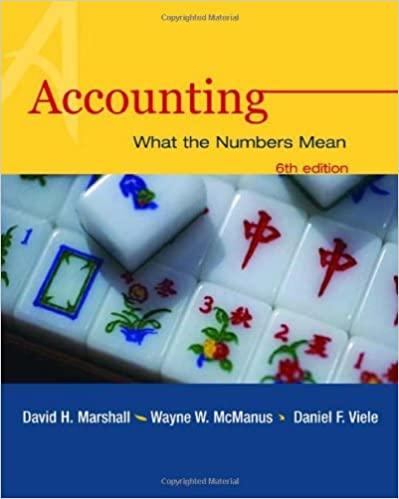Problem 3-14A Compute and Use Activity Rates to Determine the Costs of Serving Customers [LO3-2, LO3-3, LO3-4] Ginos Restaurant is a popular restaurant in Boston,
Problem 3-14A Compute and Use Activity Rates to Determine the Costs of Serving Customers [LO3-2, LO3-3, LO3-4]
| Ginos Restaurant is a popular restaurant in Boston, Massachusetts. The owner of the restaurant has been trying to better understand costs at the restaurant and has hired a student intern to conduct an activity-based costing study. The intern, in consultation with the owner, identified the following major activities: |
| Activity Cost Pool | Activity Measure |
| Serving a party of diners | Number of parties served |
| Serving a diner | Number of diners served |
| Serving drinks | Number of drinks ordered |
|
| |
| Some costs, such as the cost of cleaning the linens that cover the restaurant's tables, vary with the number of parties served. Other costs, such as washing plates and glasses, depends on the number of diners served or the number of drinks served. |
| Data concerning these activities are shown below. |
|
| Serving a Party | Serving a Dinner | Serving Drinks | Total | |||
| Total cost | $66,400 |
| $102,000 |
| $51,600 |
| $220,000 |
| Total activity | 8,000 | parties | 20,000 | diners | 43,000 | drinks |
|
|
| |||||||
| Prior to the activity-based costing study, the owner knew very little about the costs of the restaurant. She knew that the total cost for the month was $220,000 and that 20,000 diners had been served. Therefore, the average cost per diner was $11.00 ($220,000 20,000 diners = $11.00 per diner). |
| Required: | |
| 1. | Compute the activity rates for each of the three activities. (Round your answers to 2 decimal places.) |
|
|
|
|
| |
| 2. | According to the activity-based costing system, what is the total cost of serving each of the following parties of diners? (Do not round intermediate calculations. Round your final answers to 2 decimal places.) |
| a. | A party of four diners who order three drinks in total. |
| b. | A party of two diners who do not order any drinks. |
| c. | A party of one diner who orders two drinks. |
|
|
|
|
|
| 3. | Convert the total costs you computed in part (1) above to costs per diner. In other words, what is the average cost per diner for serving each of the following parties? (Do not round intermediate calculations. Round your final answers to 2 decimal places.) |
| a. | A party of four diners who order three drinks in total. |
| b. | A party of two diners who do not order any drinks. |
| c. | A party of one diner who orders two drinks. |
Problem 3-14A Compute and Use Activity Rates to Determine the Costs of Serving Customers [LO3-2, LO3-3, LO3-4] Ginos Restaurant is a popular restaurant in Boston, Massachusetts. The owner of the restaurant has been trying to better understand costs at the restaurant and has hired a student intern to conduct an activity-based costing study. The intern, in consultation with the owner, identified the following major activities: Activity Cost Pool Activity Measure Serving a party of diners Number of parties served Serving a diner Number of diners served Serving drinks Number of drinks ordered ________________________________________ Some costs, such as the cost of cleaning the linens that cover the restaurant's tables, vary with the number of parties served. Other costs, such as washing plates and glasses, depends on the number of diners served or the number of drinks served. Data concerning these activities are shown below. Serving a Party Serving a Dinner Serving Drinks Total Total cost $66,400 $102,000 $51,600 $220,000 Total activity 8,000 parties 20,000 diners 43,000 drinks ________________________________________ Prior to the activity-based costing study, the owner knew very little about the costs of the restaurant. She knew that the total cost for the month was $220,000 and that 20,000 diners had been served. Therefore, the average cost per diner was $11.00 ($220,000 20,000 diners = $11.00 per diner). Required: 1. Compute the activity rates for each of the three activities. (Round your answers to 2 decimal places.) 2. According to the activity-based costing system, what is the total cost of serving each of the following parties of diners? (Do not round intermediate calculations. Round your final answers to 2 decimal places.) a. A party of four diners who order three drinks in total. b. A party of two diners who do not order any drinks. c. A party of one diner who orders two drinks. 3. Convert the total costs you computed in part (1) above to costs per diner. In other words, what is the average cost per diner for serving each of the following parties? (Do not round intermediate calculations. Round your final answers to 2 decimal places.) a. A party of four diners who order three drinks in total. b. A party of two diners who do not order any drinks. c. A party of one diner who orders two drinks.
Step by Step Solution
There are 3 Steps involved in it
Step: 1

See step-by-step solutions with expert insights and AI powered tools for academic success
Step: 2

Step: 3

Ace Your Homework with AI
Get the answers you need in no time with our AI-driven, step-by-step assistance
Get Started


